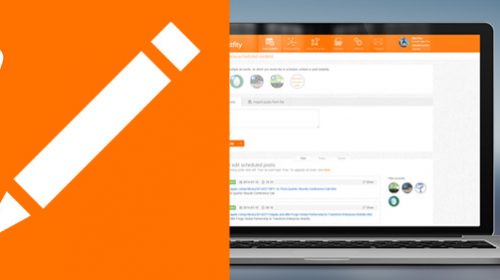LinkedIn is an unbelievably powerful social network.
It has 610 million users worldwide, almost half of whom are active monthly.
Of those active users, around 40 per cent are on LinkedIn every single day.
And yet LinkedIn tends to lag behind more glamorous platforms like Instagram, Twitter and Facebook in the level of attention marketers pay to it.
Pitch121 are a London-based marketing agency who help their clients use LinkedIn to maximise the network’s lead generating and nurturing effectiveness.
They’re hosting a free webinar this Friday December 13 at 8am GMT on Creating Conversations Online using LinkedIn and as a taster, Co-Founder and Commercial Director Laura Hannan has shared her top ten nuggets of practical advice.

1. Online Networking is Still Networking

Picture this.
You’ve just given a talk at an industry conference. It went well, and you’ve retired to the café for a well-deserved coffee.
Just as you’re settling in for that first sip, you notice a stranger standing in front of your table, staring at you with an expectant smile on his face.
You don’t know what he wants. You making fleeting eye contact. He’s looking right at you and now he gives a little cough.
You glance upwards and he smiles back, wider still this time.
“Hello…?,” you say, uncertainly.
“Hi. I enjoyed your talk just now. I’m from Acme Software. We’ve just launched our new app. Can we set up a demonstration some time this week?”
Do you take the meeting? Of course not.
It doesn’t work in real life and it doesn’t work online. So why are marketers still automating and bulk-sending generic messages to virtual strangers?
Online relationships need time to develop and for trust and rapport to build. You have to work at it and earn the right to make that sales ask.
2. Look for Conversational Triggers

Let’s give the guy at the conference in the last example a little credit. At least he knew you’d just given a talk and he used that as an opening.
We call this a “trigger” and people who are active on LinkedIn are providing cues for you to begin conversations with them all the time. You just have to know what to look for.
The content they post. The material they like, share and comment on. Their company’s activities. Discussions in groups you mutually belong to. People who you follow and know in common.
Any and all of these things can provide the trigger for the conversation you want to have with that person. You need to spot it and act on it quickly, while it’s still fresh enough for your input to provoke a response.
3. Plan Where This Conversation is Going

It won’t be every day that somebody you’re targeting drops a trigger status update like this:
“Hi – I’m looking for a new marketing automation vendor. Anybody want to pitch me?”
Usually, you’re going to have to get creative. That means knowing how you’re going to steer the conversation from the trigger to the point you need it to get to.
It may only take a quick back-and-forth of messages. It may take multiple threads over a period of months of even years.
Sharing topical content can be a great opener and it always helps to research your target thoroughly before you engage, so that you can ensure that what you say is relevant, timely and attention-grabbing.
At Pitch121, our experience has thrown up some interesting results in this respect. Attempting to start a conversation by reference to mutual connections (“Hey, I see you know x. I’m connected to her too!”) has proven really unsuccessful for us. Why? Our research suggests that a high percentage of LinkedIn connections are very loose – even tenuous. More often than not, a mutual connection does not pass any trust along to you.
Just as in face-to-face encounters, closed questions or statements are conversation killers too. If you post a question that allows somebody to end the discussion with their answer, you’ll have to start all over again.
A message saying something like “I enjoyed that video you shared” is likely – at best – to get – “thanks” as a response.

4. Allow Them to Say “No” Without Killing the Conversation

When you get to your sales ask – whether it’s a request for a meeting, a phone number, a referral or something else – you need to pose that question in a way that permits the conversation to continue if the answer is no.
Be sensitive. Be tentative. And above all, be polite.
If you steamroller a new contact with a blunt sales pitch, you’re likely to end up being ghosted and unable to ever reach that person again.
“When are you looking at reviewing your suppliers?” is a smarter question than “Are you looking at reviewing your suppliers?”
The latter can be shut down with a “no”. Any answer to the former gives you valuable information about where to go next.
But you can’t beat around the bush forever. Eventually you will have to risk rejection.
The goal is to have built enough of a relationship that “no” doesn’t finish the conversation for good.
5. Be Persistent Without Being Annoying

Information overload is real. If somebody doesn’t reply to your first message, it could very easily be because they just didn’t see it. So try again.
But do not just keep sending the same message. Be self-conscious and honest. You don’ know if they missed your message or saw it and decided not to reply. Acknowledge that, change the angle and give them a reason to reply this time.
Each message that you send needs to give something new to the reader.
Your humanity is your greatest asset here. Even if you have automated response chains, your messages must look and feel organic, tailored and personal. Cite your previous exchanges. Keep the tone and language consistent with earlier interactions. Nobody likes talking to a bot.
6. Mix Up The Platforms

Let’s face facts. Brilliant as LinkedIn is, most real business exchanges end up being transacted through email sooner or later. LinkedIn sits in that hybrid spot between personal and professional – that’s why this conversational stuff works there.
As your steer the conversation towards its destination, you may find yourself switching to other communications media such as email, text or even the telephone.
That doesn’t mean you should forget about LinkedIn. We’ve found that the switch of platforms is a key drop-off point in the progress of online conversations and relationships. Maybe your contact’s email system stops your messages getting through. Maybe they don’t recognise your email as coming from the same person they were chatting with.
This is where sending a nudge message on LinkedIn – pointing out and drawing attention to the email – can be really powerful. You’re back on the relationship’s home turf, priming your contact to take it to the next level.
7. Keep It Short, Keep It Simple

You may have a lot to say, but saying it all at once is rarely the best course of action. Your contacts are busy, so the more you ask them to read, to think or to write in order to respond to you the less likely they are to do it.
Restrict your messages to making one single point at a time. If that point is strong enough to elicit a response, you’ll get a chance to make the next point in the next message.
8. If It’s Not Working, Change It

People are people, not statistics. If your best-performing message templates don’t work on this guy, you’re going to have to try something else if he’s the guy you want to talk to.
Here’s an example from our experience.
Pitch121 were working with an agency owner, trying to expand his network among brand managers. The usual approach (“We run a networking group for brand owners. Can we connect?”) wasn’t working well. So we reconsidered.
We realised that the people we were trying to connect with were all marketers themselves – highly-attuned to and aware of ulterior motives and the way people in business use LinkedIn to pursue them.
So we made the messages self-conscious.
“Hi, I’ve been following you and your brand for a while now. It would feel a little less creepy if we connected!”
The connection rate shot up.
But what works for one audience won’t work for another. We tried the same trick on a retail audience. It didn’t work. You have to put yourself into your targets’ mindset when figuring out how to repitch your messaging.
9. Meet Up In Real Life Whenever You Can

Nothing beats a face-to-face conversation for building the trust and rapport that business relationships depend on. Even video conferencing is a poor substitute for getting in front of somebody in real life.
LinkedIn users litter their profiles with hints about how to do this. They post about conferences they’re attending. They announce where they’re going to be on certain dates and what they’re doing. If they’re coming to your town, ask if they’ve got time for a coffee. It doesn’t have to be a sales meeting – just always be on the look out for opportunities to take that online relationship offline.
10. Take Your Time, Stay In Mind

As we mentioned earlier, some online relationships take months or even years before they get to where you want them to be. And that might include long periods during which you’re not actively speaking to one another: for example, if you know a prospective client is interested in your service but is tied in with a current supplier for the next six months.
Out of sight, out of mind.
You need to keep yourself in your target’s mind. Not constantly. Not in an aggressive, irritating or single-minded way. Just now and again. Whenever it’s appropriate. And in a way that let’s them know you’re thinking about them – so that they think about you.
Like, share or comment on their posts. Tag them when you post content you think may be useful. Do favours without expectation of return because those are the ones that most often do get returned!
For example, I offered to share a contact’s webinar invitation to my own network – just as a matter of keeping myself visible. When I later came to ask for a sales call, he agreed to it and told me that he never usually takes such meetings. He only agreed because I had helped him out previously. We won the business, and it all seemed completely like serendipity to our client.
It wasn’t. It took planning, patience and thought, so that we were in the right place at the right time.
If you would like Pitch121 to help you have more meaningful conversations with people you would love to work with then contact Laura on laura.hannan@pitch121.com



